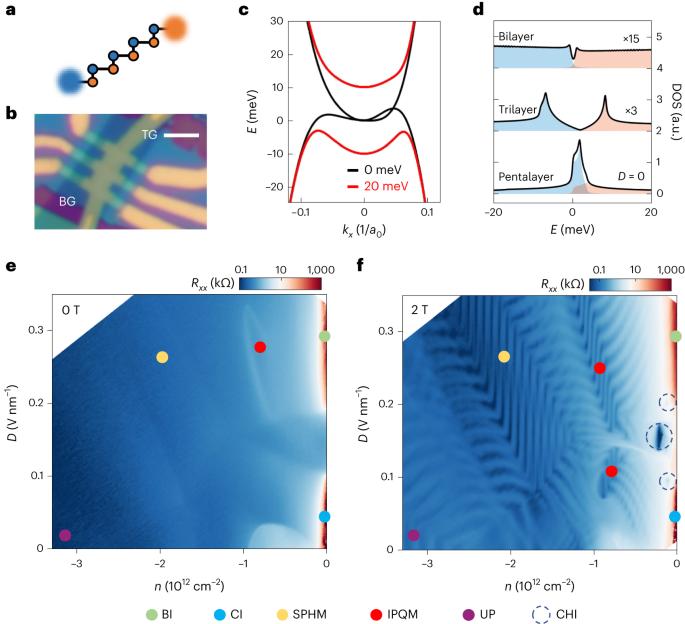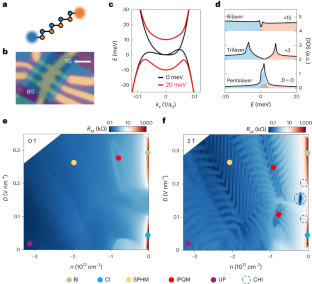Correlated insulator and Chern insulators in pentalayer rhombohedral-stacked graphene
IF 38.1
1区 材料科学
Q1 MATERIALS SCIENCE, MULTIDISCIPLINARY
引用次数: 0
Abstract
Rhombohedral-stacked multilayer graphene hosts a pair of flat bands touching at zero energy, which should give rise to correlated electron phenomena that can be tuned further by an electric field. Moreover, when electron correlation breaks the isospin symmetry, the valley-dependent Berry phase at zero energy may give rise to topologically non-trivial states. Here we measure electron transport through hexagonal boron nitride-encapsulated pentalayer graphene down to 100 mK. We observed a correlated insulating state with resistance at the megaohm level or greater at charge density n = 0 and displacement field D = 0. Tight-binding calculations predict a metallic ground state under these conditions. By increasing D, we observed a Chern insulator state with C = −5 and two other states with C = −3 at a magnetic field of around 1 T. At high D and n, we observed isospin-polarized quarter- and half-metals. Hence, rhombohedral pentalayer graphene exhibits two different types of Fermi-surface instability, one driven by a pair of flat bands touching at zero energy, and one induced by the Stoner mechanism in a single flat band. Our results establish rhombohedral multilayer graphene as a suitable system for exploring intertwined electron correlation and topology phenomena in natural graphitic materials without the need for moiré superlattice engineering. Pentalayer graphene in the rhombohedral stacking order exhibits rich phases including a correlated insulator, isospin-polarized metals and Chern insulators. These findings demonstrate electron-correlated and topological states in crystalline 2D materials without the need for a moiré superlattice.


五层菱形堆叠石墨烯中的相关绝缘体和Chern绝缘体。
菱形堆叠的多层石墨烯具有一对在零能量下接触的平带,这应该会产生相关的电子现象,可以通过电场进一步调节。此外,当电子关联破坏同位旋对称性时,零能量的依赖于谷的Berry相可能会产生拓扑上的非平凡态。在这里,我们测量了通过六方氮化硼封装的五层石墨烯的电子输运,低至100 mK.我们在电荷密度n下观察到与兆欧姆或更大电阻相关的绝缘状态 = 0和位移场D = 紧密结合计算预测在这些条件下的金属基态。通过增加D,我们观察到具有C的Chern绝缘体态 = -5和另外两个带有C的状态 = -在大约1的磁场下为3 T.在高D和高n下,我们观察到同位旋极化的四分之一和半金属。因此,菱形五层石墨烯表现出两种不同类型的费米表面不稳定性,一种由一对在零能量下接触的平带驱动,另一种由单个平带中的Stoner机制诱导。我们的结果建立了菱形多层石墨烯作为一种合适的系统,用于探索天然石墨材料中相互交织的电子关联和拓扑现象,而无需莫尔超晶格工程。
本文章由计算机程序翻译,如有差异,请以英文原文为准。
求助全文
约1分钟内获得全文
求助全文
来源期刊

Nature nanotechnology
工程技术-材料科学:综合
CiteScore
59.70
自引率
0.80%
发文量
196
审稿时长
4-8 weeks
期刊介绍:
Nature Nanotechnology is a prestigious journal that publishes high-quality papers in various areas of nanoscience and nanotechnology. The journal focuses on the design, characterization, and production of structures, devices, and systems that manipulate and control materials at atomic, molecular, and macromolecular scales. It encompasses both bottom-up and top-down approaches, as well as their combinations.
Furthermore, Nature Nanotechnology fosters the exchange of ideas among researchers from diverse disciplines such as chemistry, physics, material science, biomedical research, engineering, and more. It promotes collaboration at the forefront of this multidisciplinary field. The journal covers a wide range of topics, from fundamental research in physics, chemistry, and biology, including computational work and simulations, to the development of innovative devices and technologies for various industrial sectors such as information technology, medicine, manufacturing, high-performance materials, energy, and environmental technologies. It includes coverage of organic, inorganic, and hybrid materials.
 求助内容:
求助内容: 应助结果提醒方式:
应助结果提醒方式:


